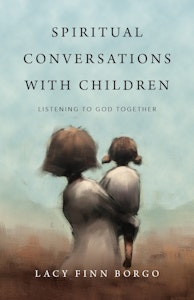 Excerpt from Spiritual Conversations with Children
Excerpt from Spiritual Conversations with Children
Birds fly, fish swim, and children play. —Garry Landreth
In Mark 8:22 – 26 we catch a glimpse of a playful Jesus.
When a blind man asks for healing, Jesus leads him out of the village — where presumably there were fewer spectators — and then as John records it, proceeds to make mud with his own spit ( John 9:6). There is something childlike and playful about Jesus healing a blind man with mud made from his own spit. Perhaps Jesus tapped into his own childhood self for this miracle. But things get even more playful when at first it seems the mud does not completely resolve the problem. The man sees something “like trees” walking. The lack of efficiency found in two tries and the willingness to test the process are elements found in play. Lightness, freedom, vulnerability, and healing flow from play. Jesus seems to have known that and like his Father has an infinite capacity for play.
Play is the mother tongue of children. Adults communicate through verbalization, but children who are new to words communicate through play and movement. Play is an essential part of having spiritual conversations with children. It is the primary communication medium. In play children use toys or objects to express, engage, and work out their inner life. Play provides a “symbolic language of self-expression” that can offer us clues to what the child has experienced. During play, children reflect on and make meaning of their experiences, and they resolve the questions that have been stirred up by those experiences. Play allows a child a measure of control in a life governed by adults and can help children feel more secure and safe. Play is more of a process and less of an outcome, which in itself is a freedom and a characteristic of spiritual conversations. And we can be sure that since play is the primary mode of communication for children, God speaks the language of play.
Play and Projection: Tools for Knowing
Play and projection are tools for knowing God and knowing self when listening to God with children. Play can incorporate wonder and mystery as well as create the conditions for union. An example of spiritual conversations with children is playing out the scene of the good Shepherd with wooden objects depicting the story. The adult first tells the story of the good Shepherd, according to a childlike version of Psalm 23, using wooden objects. Then the adult invites the child to play the story. The framework of “playing the story” is the story itself, simply told by the adult. The child is then invited to retell that story and to fill in the framework with their own variations, imaginations, and knowledge.
For example, I have witnessed several children move the Shepherd to tame the lion, who represents the enemy wanting to harm the sheep in Psalm 23. The Shepherd taming the lion is not part of the biblical story in this passage, but it does represent the deeper longing children have for peace and harmony. I have also seen children move the lion to kill everyone, the Shepherd and the sheep. The killer lion is certainly not part of the biblical story either. Here we get a glimpse of the aggression, anger, and frustration that the child feels. The adult listens and watches for the movement of the Spirit as the child plays. Sometimes the Spirit will prompt a divinely curious question, “I wonder why the lion is attacking the sheep?” or reflect back, “I see that the lion is angry.”
Sometimes the child will invite the adult into the play, “You be the shepherd” or “You be the lion.” As the guest in the play, the adult allows the child to direct. Adults do not step in and reroute, direct, or correct the play in any way. We rest in the unwavering reality that the Spirit is attending whatever is happening within the child. For the child, God is their play partner.
Keeping Catherine Garvey’s five criteria of play in mind can help us to notice when a child has moved into play and remind us to surrender our need to problem solve or direct the play.
- Play is pleasurable.
- Play is done for itself.
- Play is voluntary.
- Play involves deep concentration.
- Play has links to the creative process, problem solving, the learning of languages and social roles.
Whatever toys or other materials used need to be carefully chosen. The toys must be both engaging and boring enough that a story can be projected on them. For example, video games are engaging, but they are not boring or blank enough to be used in spiritual conversations with children. Toys need to be able to facilitate creative, emotional, and experiential expression. Perhaps it goes without saying, but toys also need to be organized and well kept. A space full of broken electronic toys will distract rather than engage. The aim is to open the space for the child to be heard in the language most natural to them. The aim is not to entertain or placate the child. Play and entertainment are not the same. Interesting enough entertainment does not generally draw us into connection and self-revelation. Play, however, channels the connective energy of experience and exploration.
Children project their interior life through the objects during play. As a result, their projection is a helpful tool for spiritual conversation in that it exposes a bit of their interior lives to the light of day and the praying presence of a listening adult. Children often project their most pressing emotion or need during play, meaning that the objects they play with and the characteristic of the play mirror their own emotion or need. Children play out their concerns and sorrows, their joys and triumphs. Children also play out their perceptions of God, of self, and of the authority figures in their lives. They often play the same theme over and over again as they work through it. When a child ceases to explore a particular theme in play, the adult listener can assume that the child has found a resolution that satisfies them for the time being. Play allows children to not only get in touch with God, but it allows children to get in touch with their own inner wisdom. When a listening adult is allowed to witness these sacred perceptions and progressions, the room becomes holy ground.
Creating as Play
Children also play by creating. Having art materials on hand like watercolor paints and watercolor paper or clay to sculpt can provide another medium for projection. Children who are not familiar with Jesus or who may have different religious traditions not connected to Jesus need not miss out on the gift of a listening adult. Inviting a child to draw or create something that tells the story of their experience of goodness, beauty, or truth encapsulates the benefits of projection and connects the child with their Creator through the act of creation. Children are born creators and will build or shape almost anything to express themselves. LEGO blocks are a wonderful medium for children to create their communication with God.
In any given listening session, playing and creating might look like imagining a story with the characters from Inside Out, a Pixar film about feelings, to tell about anger, sadness, joy, fear, or disgust. It might look like playing out one of the stories from the life of Jesus with wooden toys. It might look like playing a game of Jenga while exploring existential questions. Through imagination, play helps children integrate their outer world and their “inner perception of meaning.”
Soaking It In
The following are suggested topics for conversation with God, with others, or even with yourself. As a child’s conversation with God includes activity, allow these activities to be conversation.
- Locate a place to observe children at play. The nursery at your local house of worship or a preschool are good places to check. Be sure to obtain permission, explaining that you are seeking to learn to “hear” children while they are playing.
- As you are observing, notice your own thoughts or feelings. Do some of your own childhood experiences come to mind?
- Notice one child who captures your attention, ask the Spirit to help you “hear” what the child is saying through prayer. What longings or desires do you hear? Pray for this child while listening.
- Locate a child who will teach you to play. It may be a family member or a friend of your family. Ask the child to teach you to play. Allow the child to choose the activity and direct you while you play.
- Notice your resonance and resistance while playing.
- Notice when you lose track of time.
- What is one thing you liked to do when you were a child? Did you love to dance, ride horses, or paint? Take some time to reintroduce yourself to this play practice.
Taken from Spiritual Conversations with Children by Lacy Finn Borgo Copyright © 2020 by Lacy Finn Borgo. Published by InterVarsity Press, Downers Grove, IL. www.ivpress.com
Photo by Caleb Angel on Unsplash
Text First Published February 2020


